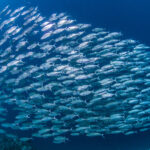Have you ever looked up at the night sky and wondered about the strange glowing phenomenon that appears to resemble a jellyfish? Whether it’s the result of natural processes or a rare meteorological event, this eerie, luminous display has intrigued stargazers and skywatchers for years. Known by various names, the glowing jellyfish in the sky is often linked to a type of atmospheric optical effect, but its true origin can be traced back to a series of fascinating natural events.
In this article, we’ll explore the glowing jellyfish phenomenon, unravel its scientific explanations, and take a closer look at what causes this captivating light show in the sky.
The Phenomenon: What Is It?
The “glowing jellyfish” you might see in the sky isn’t an actual creature drifting in the atmosphere. Instead, it is a natural optical effect caused by specific weather conditions, atmospheric phenomena, and sometimes even human-made objects like rockets or satellites. The sight is often described as a glowing, ethereal, jellyfish-shaped light, usually visible during twilight or early evening hours.
Atmospheric Phenomena
The most common explanation for this mysterious sky display is a phenomenon known as “Noctilucent Clouds”. Noctilucent clouds are high-altitude clouds that form between 50 to 85 kilometers (31 to 53 miles) above Earth’s surface, at the edge of space. These clouds are made of ice crystals and typically appear during the summer months when the sun is just below the horizon, casting light onto them even though it is nighttime on the ground.
These ice crystals can reflect the sunlight and give the clouds a soft, glowing appearance, often showing off brilliant hues of blue, white, and even purples. When these clouds form in unique shapes or patterns, some observers describe them as looking like a glowing jellyfish. The jellyfish-like shape comes from the tendrils and undulating forms that can be seen as the clouds move across the sky.
Rocket Launches and Space Debris
Another source of these glowing sky displays could be rocket launches or space debris re-entering Earth’s atmosphere. When a rocket launches, it can leave behind a luminous trail in the sky. The bright light may reflect off ice particles or even interact with the atmosphere, creating a glowing, sometimes jellyfish-like appearance.
Space debris, when entering the atmosphere, can also burn up and leave behind a glowing trail of plasma, often taking on strange, organic forms in the process. The size and shape of these trails can sometimes resemble the tentacles of a jellyfish, adding to the mystery of the phenomenon.
Iridescent Clouds
In some cases, the glowing jellyfish effect could be related to iridescent clouds, which occur when sunlight shines on water droplets or ice crystals in the atmosphere, creating rainbow-like colors. This can happen at high altitudes and under specific conditions, sometimes producing a delicate, glowing halo that some might interpret as a jellyfish shape.
Why Does it Glow?
The glow that is typically observed in the sky during these phenomena is a result of the way sunlight interacts with particles in the atmosphere. During twilight, when the sun is just below the horizon, its light can be scattered and refracted by the particles high up in the atmosphere. This scattered light is often strong enough to make the clouds or other atmospheric phenomena glow. The specific wavelengths of light that are scattered can create the glowing colors that appear as the light from the setting or rising sun shines on the ice crystals or vapor in the clouds.
Why the Jellyfish Shape?
The jellyfish-like shape that some people observe in the sky can be due to the irregular formation of clouds or the way sunlight interacts with these clouds. When Noctilucent clouds form, they are often long and thin with wisps or tendrils extending from the center. These tendrils may resemble the tentacles of a jellyfish, adding to the visual illusion of the phenomenon. Moreover, the motion of these clouds and their delicate, ethereal quality can make them seem as though they’re floating across the sky in a fluid, jellyfish-like manner.
The Role of Human Perception
It’s also important to consider that human perception can sometimes exaggerate or influence what we see. Our brains are wired to recognize patterns and shapes, especially organic ones. Therefore, when we look at the sky, we may subconsciously interpret certain cloud formations, especially ones that resemble biological shapes, as jellyfish-like. This visual interpretation can make the phenomenon appear even more mystical or strange.
Where and When Can You See It?
The glowing jellyfish effect is not an everyday occurrence, but it can be spotted in specific conditions. Noctilucent clouds are most commonly visible during the summer months at higher latitudes, typically between 50 and 70 degrees north or south of the equator. The best time to see them is just after sunset or just before sunrise when the sky is dark, but the sun’s light still illuminates the high-altitude clouds.
Rocket launches or space debris events can be observed more sporadically and depend on the timing of these events. They can occur anywhere, but the chances of seeing a jellyfish-like trail from a rocket are generally higher during scheduled launches from major spaceports.
Conclusion
The glowing jellyfish in the sky is an awe-inspiring phenomenon that blends the wonders of natural atmospheric processes with the mysteries of human exploration in space. Whether it’s the glowing tendrils of Noctilucent clouds, a rocket launch leaving a luminous trail, or space debris entering Earth’s atmosphere, this captivating light show is a testament to the beauty and complexity of the skies above us. So, the next time you see this celestial display, you’ll know that you’re witnessing a rare and fascinating phenomenon caused by the interplay of light, weather, and even space exploration.



